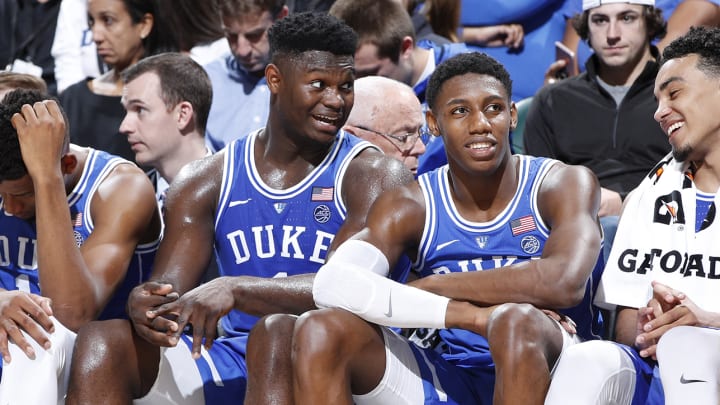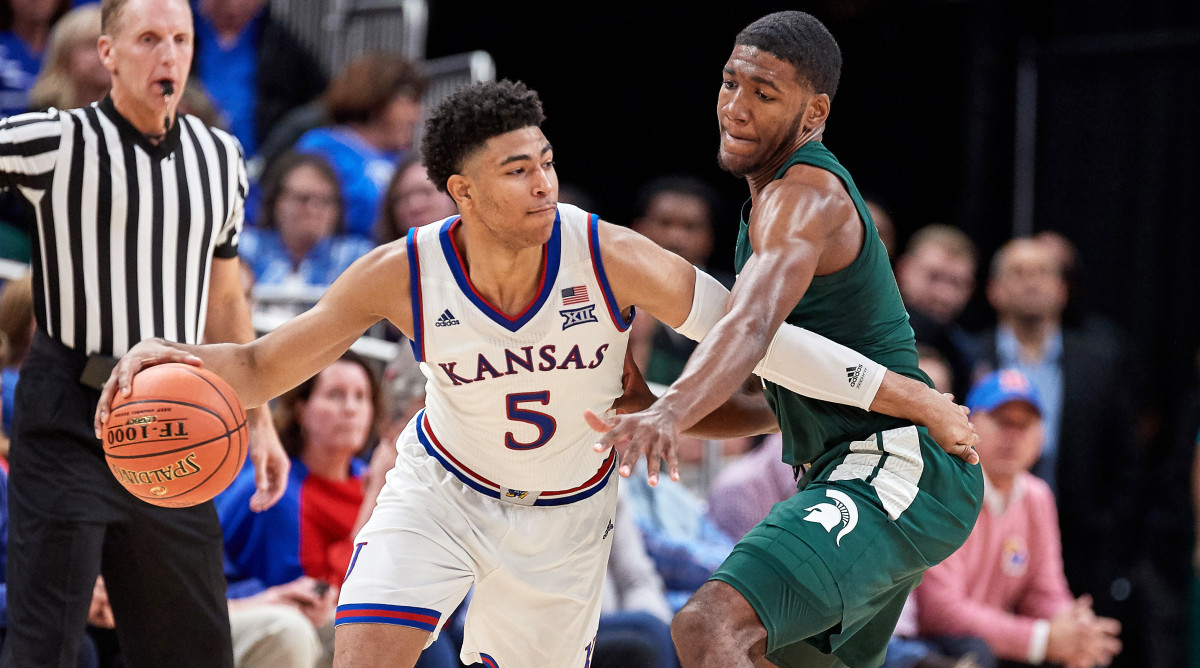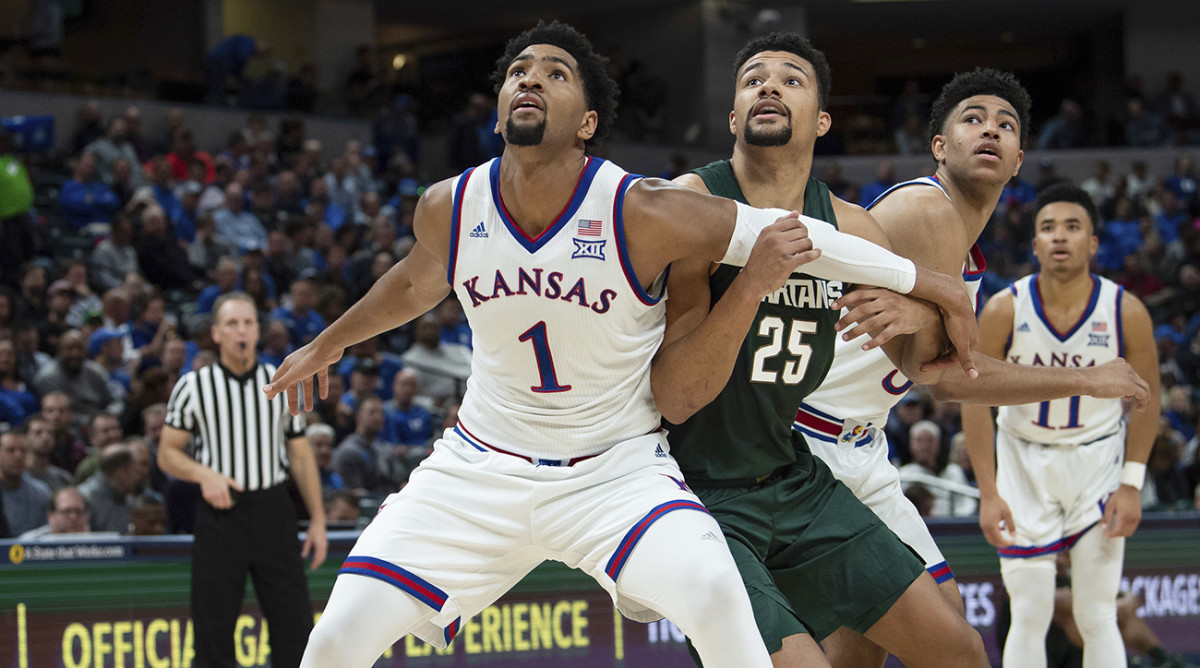Analyzing the Best NBA Draft Prospects From Champions Classic

INDIANAPOLIS — Tuesday night’s Champions Classic games stood as a sufficiently rousing start to the college basketball season, which has come to double as the unofficial commencement of the 2019 NBA draft conversation. Between Duke’s steady thrashing of Kentucky, a promising showing from Kansas against Michigan State, and nearly two dozen pro prospects in action as high-ranking league executives lined the stands at Bankers Life Fieldhouse in Indianapolis, there was a lot for everyone to process. One game is never conclusive, much less the first one of the season, but this event has come to hold a bit of added weight in terms of magnified exposure, and how frequently those programs have produced top draft picks over the past half-decade.
There was some sentiment going around in Indy that everyone involved would benefit from an event like this being held in say, January—college teams and players tend to evolve quite a bit over the course of the season as they iron out the kinks, figure out roles and are given the requisite time young players take to cohere. But noting the circumstances and knowing what we knew coming into the night, it’s worth giving these prospects some initial thought.
The Crossover’s Front Office was on hand in Indianapolis to break things down. Here’s how the notable prospects fared.

Zion Williamson, Duke
The top-ranked prospect on our preseason draft board, Williamson was the most efficient, most athletic and most unselfish player on the floor as Duke rolled over Kentucky with startling ease. Scoring 28 points in 23 minutes on just 13 shots was impressive unto itself. He may be unstoppable with a head of steam, but Williamson’s game contains a great deal of nuance. Everyone knew he was a special athlete, but it’s his overall ability to process things on the fly, make decisions and impact winning within the flow of a game that should have doubters on notice.
Williamson has a unique ability to fly in out of nowhere, bump an opponent out of the way and wrest control of the ball to start a break or generate a second chance. The sheer surprise factor in those plays caused a few tangible shifts in momentum. He threw a number of outstanding passes to create shots for teammates and needle a leaky Kentucky defense. He blocked a shot by simply leaping to snatch it out of the air, then turned it into a fast break. These are not normal things for any player, much less an 18-year-old one. It’s fair to ask about his jumper (he did make a three and a pull-up long two), and that he improve his handle (it can get loose, particularly going to his right).
Still, it’s increasingly obvious that debate about Williamson’s future position as it pertains to his value should be irrelevant. Teams should want the ball in his hands a lot, he will draw tons of free throws, and he should make enough plays without it to deploy him creatively. In a league where P.J. Tucker can effectively guard centers, Williamson’s bulk, athleticism and rebounding skills will find him a home. More than anyone in action, his performance left NBA teams with plenty to chew on. He made an awfully strong case for himself as a potential No. 1 pick.
R.J. Barrett, Duke
Also squarely in the mix for the No. 1 selection, Barrett set a Duke freshman record with 33 points on the night, his relentless assault on the paint a large reason why his team nearly doubled a 17-point halftime lead. There are few college defenders that can adequately quarantine him, and not many holes in his game—he hit a reassuring trio of shots from outside, managed six assists, pushed the ball in transition and was present defensively, although Keldon Johnson got the better of him a couple times. It’s Barrett’s bankability that makes him such an appealing prospect, his ability to generate offense and draw contact helping to establish a starter-caliber floor, with room for growth as a pull-up shooter setting his ceiling higher.
A big part of what makes Barrett so good is his ability to change direction and score on the move. He attacks downhill with long strides, has an advanced understanding of angles and is willing to drive into the chest of his defender. More often than not, he’ll draw the contact or create a good look from in close. Barrett frequently looks to score off penetration, but will drop off a pass as a last resort. Sometimes he’ll put his head down and play predictably, but that doesn’t make it harder to stop at this level. If you wanted to nitpick, you could note that Barrett took a whopping 26 shots (he did make half) and made just half of his eight free throws, but he was forced into additional minutes on some level after Williamson and Cam Reddish picked up early fouls.
If Barrett continues to show improvement as a shooter while scoring at a consistently high clip with a demonstrably killer instinct, he’ll be a lock as a top-two selection. It’s difficult to see many teams passing on such a polished, well-rounded wing. Right now, the only player who’s legitimately challenging him is Williamson, and if Tuesday is to be believed, they’ll actually stand to benefit from playing off each other. Their respective showings were the story of the night.
WOO: Zion Williamson Tops 2019 NBA Draft Big Board Rankings
Cam Reddish, Duke
While Reddish certainly played well on Tuesday, it was evident why he’s taken on more of a third-banana spot in Duke’s hierarchy. He scored 22 points, made three of eight threes, picked his spots effectively and also accrued four steals, using his length to cause problems for Kentucky. He didn’t do much to showcase his passing ability, but expect that to shine through over the course of the season. He remains a major talent, and there will be nights where we wonder if he’s actually the most gifted guy on the team. Reddish will have to continue fighting his reputation for fading into the background, which dates back to high school—NBA teams still need to be convinced he cares. He did a solid job of staying involved in the game, and the Duke spotlight may be a boon for him as an platform to shift opinion a bit. If he raises his game this season, it’s hard to see anyone beating them.
Keldon Johnson, Kentucky
Johnson and Reid Travis were the only Kentucky players who acquitted themselves well as the blowout escalated, and that wasn’t especially surprising. Johnson isn’t quite as explosive as his Duke counterparts, but he leaves nothing on the table and did a good job of staying locked in, scoreboard aside. He didn’t force much offense and showed a good amount of patience early in the game while attacking Barrett. Johnson is an expert finisher, uses the glass well and has a particularly strong in-between game for his age, and NBA teams will appreciate how badly he wants to win at all times, a quality that appears genuine. He managed 23 points, looked like he belonged on the floor, and should shine as his team’s best player as Kentucky inevitably trends back upward.

Quentin Grimes, Kansas
The early game between Kansas and Michigan State was more or less Grimes’s show. His biggest swing skill coming into the season was his three-point shooting, so naturally he spotted up and shot 6-of-10 from beyond the arc, helping stake a big first-half lead. He finished with 21 points to pace the team. The Jayhawks are clearly better with him on the floor, and his combination of size, know-how and passing feel enables him to fit into various lineups with ease. When his jump shot isn’t falling, Grimes can blend into the game if the ball isn’t in his hands, so continuing to be a viable threat spacing the floor is vital to his effectiveness both short and long-term. I’d like to see him get into the paint and penetrate more, but within Kansas’ inside-out system, he shone in the pass-and-space role he played Tuesday (and the Jayhawks struggled a bit in the second half with him off the floor). He will need to score the ball more aggressively to suggest he has a star ceiling, but even if that doesn’t materialize, his combo-guard skill set should play. There will be some ups and downs for him, but Grimes continues to be a pretty safe bet to land in the Top 10 in June.
Tyler Herro, Kentucky
There’s been a good amount of first-round chatter surrounding Herro, who had an abysmal shooting night before settling down once the game was more or less over in the second half. Teams love his ability to shoot from distance and effectively create space for his jumper off the dribble or catch. He’s a decisive offensive player and has more handling ability and toughness to him than is often advertised. Herro’s willingness to take risky shots and John Calipari’s green light can make his bad games look horrendous, and that was more or less what happened as he was thrown into the fire Tuesday. There will be also nights when he looks like the Wildcats’ best player, and some of that will be dependent on the improvement of point guards Ashton Hagans and Immanuel Quickley, who are still grasping what Kentucky wants to do. Players with Herro’s offensive versatility are always in demand, even if he’s going to give up points on the other end. If he can fill out offensively and settle into his role, it seems likely he’ll play his way into a Top-30 selection in June.
P.J. Washington, Kentucky
This was a nightmare matchup for Washington, who was often tasked with guarding one of Duke’s bigger wing players out of necessity. He scored just eight points and struggled to establish himself offensively in the flow of the game. He remains an intriguing, versatile big, and looks to be in much better shape than last season—better days are ahead once this unfinished Kentucky team starts to settle on a rotation and roles. But it was a quiet night overall as he battled foul trouble.
WOO: 25 College Teams NBA Fans Should Care About This Season
Reid Travis, Kentucky
Travis’s vocal leadership as the game crumbled around him was impressive, and his ability to move laterally, hedge screens and rebound make him an intriguing role player candidate going forward. His advanced age as a grad transfer suggests this is more or less what he’s going to be, and his lack of impact as a shot-blocker and overall verticality beneath the basket will likely set him back when it comes to draft position. Travis is going to win some teams over from an intangibles standpoint, and he quietly amassed 22 points and made 9-of-13 free throws while remaining poised throughout. Expect him to be on the floor more often than not as Kentucky sifts through lineup combinations.
Udoka Azubuike, Kansas
Azubuike looked noticeably trimmer as he pounded his way around the paint for 17 points. He only grabbed three rebounds, and remains a dated player archetype—in many ways he is what he is, and there’s not much reason to think his game will fundamentally expand. He’s improved, but he remains a second-round type prospect, with his size and footwork at least worthy of a flier. Kansas fans will enjoy having him around.
Devon Dotson, Kansas
Dotson did a good job of stabilizing the Jayhawks at the point in his debut, scoring 16 points and knocking down three triples. Because of his slight, smallish build and lack of one killer skill, right now he probably falls in as more of a two or three-year prospect. He stands to improve running the team (he turned it over four times, had just three assists and was occasionally slow making decisions) and as a consistent jump shooter before convincing teams he has a place in the league. A continued string of strong performances could change some minds.

Dedric Lawson, Kansas
With a final line of 20 points (despite 5-of-18 shooting), 14 rebounds, six assists, two blocks and two steals, Lawson is going to be the type of player analytically-oriented teams consider strongly. He was a stat-stuffer at Memphis and will continue to do so in a Kansas system that plays through the frontcourt. But he is absolutely not an eye-test guy. His lack of vertical explosiveness frequently evident, cost him a number of finishes both simple and contested. Some of the mid-range shots he took and missed would be bit inexcusable at the next level. He’s a prospect, but certainly an odd one, and due to his shortcomings, more likely a second-rounder whenever he ends up in the draft.
Tre Jones, Duke
Jones is going to be tasked with moving the ball, hitting open threes and making plays opportunistically in transition. Because of the team around him, he won’t need to do a whole lot else to be effective. He will obviously be seen a ton, which seems more likely to help him next season as he’d end up with a much larger role if he returns given the likely departures of his three freshman counterparts. He’s extremely important to his team, and will end up a draftable prospect, but it shouldn’t be assumed that it happens this season.
RAGATZ: Barrett Asserts Himself as Duke's Best Player
E.J. Montgomery, Kentucky
For what it was worth, the Wildcats managed to play a bit better when combining Montgomery with Travis up front, generating a more skilled and defensively mobile look. Montgomery looked lost to start the game, but got better as it went on and came up with some energy plays after things had gotten out of hand. His size and potential as a versatile big continue to pique interest, but he can’t be fully counted on yet. One would hope he rises to the occasion as the season goes on.
Nick Richards, Kentucky
This was a disappointing turn from Richards, who looked to have improved over the summer but inspired little confidence in a game where he scored zero points and got lost in the shuffle of transition. His impressive athletic tools at his size would suggest Kentucky could have used him as a defensive presence in this matchup, but from a feel standpoint he continues to come along slowly. As an older sophomore, Richards will need to show some positive signs early in the season or perhaps risk falling out of the rotation as Kentucky tinkers.
Nick Ward, Michigan State
Ostensibly Michigan State’s best player coming into the game, Ward confirmed doubts about his ability to play against length and has limited long-term viability as an NBA prospect. He still stands to get into better shape, but his offensive bag of tricks is somewhat rudimentary for a big guy with such soft touch. Ward’s play will obviously improve, but his inclusion on this list is indicative of Michigan State’s overall lack of immediate draft prospects on the roster, something NBA scouts lamented a bit over the course of the night.
